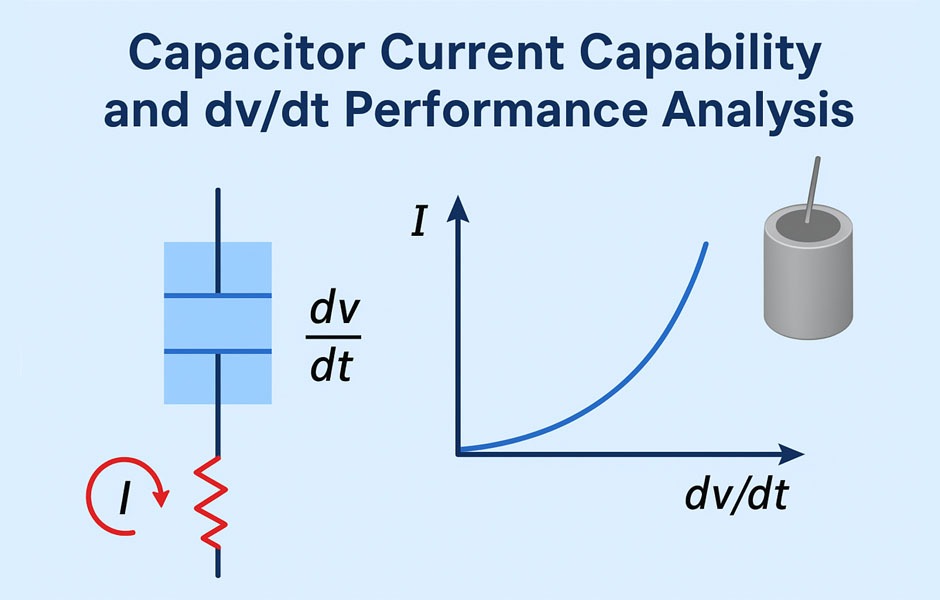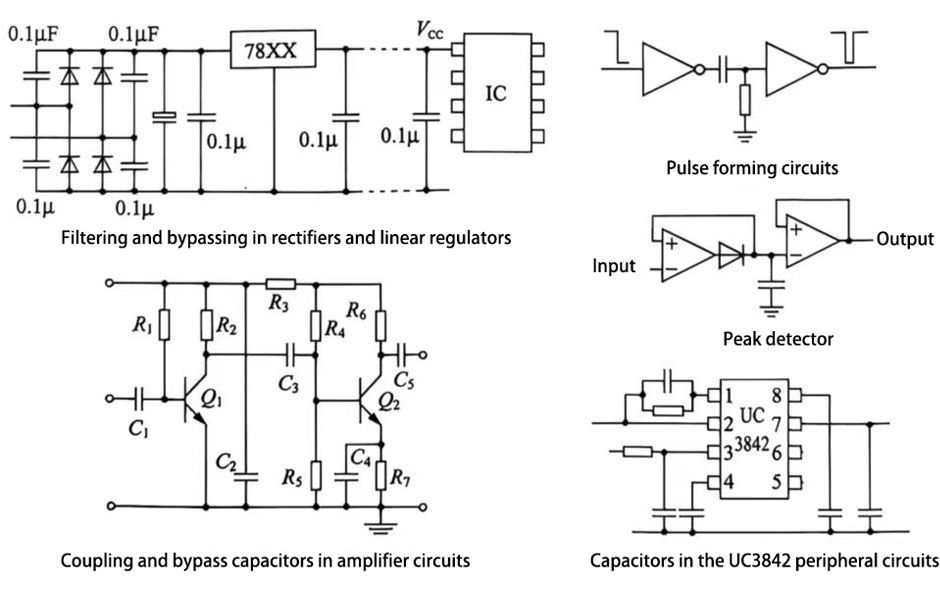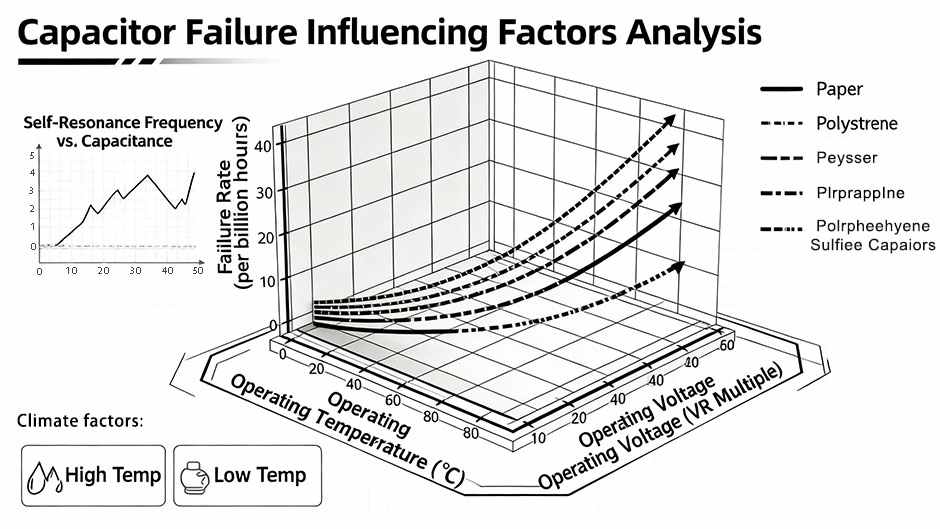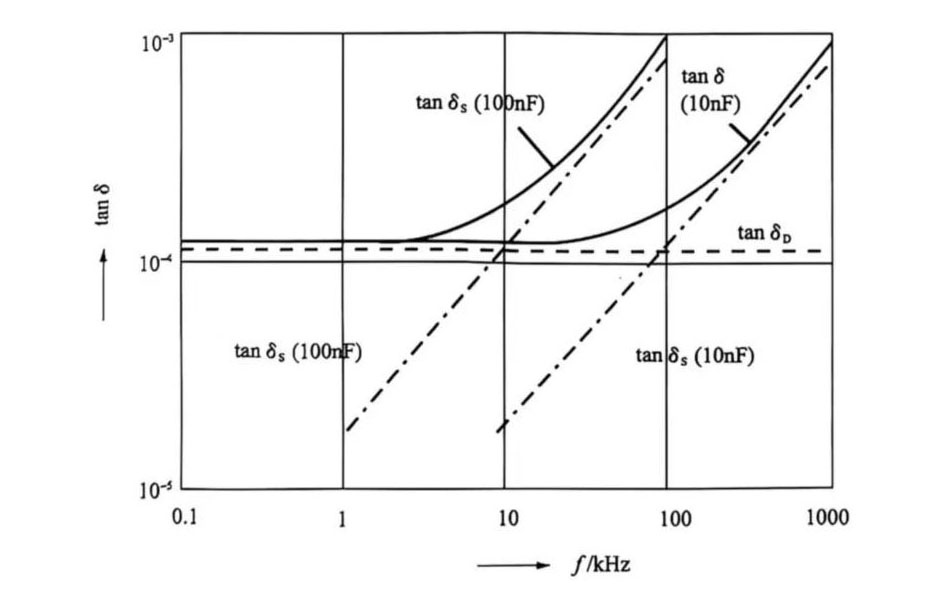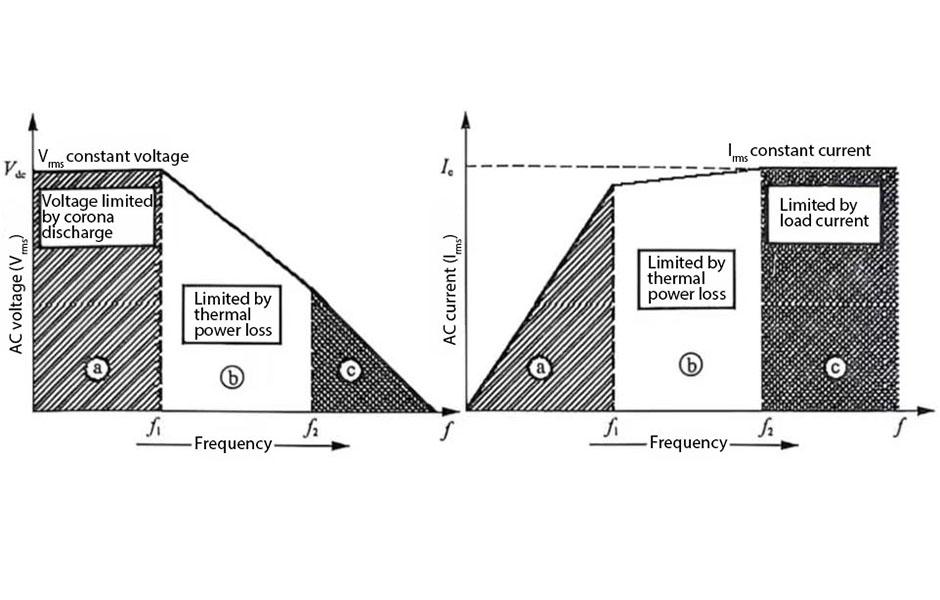1 Paper dielectric capacitor
The dielectric constant of capacitor paper is about 2.2. Since it is made of plant cellulose, it is porous and generally contains 20%~35% (volume fraction) of air and 5%~7% (mass fraction) of water. Therefore, when manufacturing organic capacitor materials, it is necessary to dry and impregnate to remove moisture. Usually, liquid or solid filling with high dielectric constant and insulation strength is selected for impregnation to improve the dielectric constant and insulation strength.
Paper dielectric capacitor (paper dielectric capacitor) is a winding capacitor with capacitor paper as dielectric and aluminum foil as electrode. It has two structures: sealed and semi-sealed.
The characteristics of paper dielectric capacitor are: wide range of capacitance and working voltage, simple process, low cost, and easy metallization. Today’s paper dielectric is usually combined with organic dielectric, making full use of the advantages of good metallization performance of paper dielectric to make excellent capacitors such as bimetallized capacitors.
2 Organic dielectric capacitor
Capacitors made of capacitor paper or synthetic organic film as dielectric material are called organic dielectric capacitors (organic dielectric capacitor). This type of capacitor is mostly a winding structure, and its electrodes are metal foil electrodes and metallized electrodes.
The main characteristics of organic dielectric capacitors are: the thickness of the film can be made very thin and easy to wind, so the capacitance and working voltage range of this capacitor are very wide. Organic dielectric materials are mostly synthetic polymers, with abundant raw materials and a wide variety, which is conducive to the development of organic dielectric capacitors. Compared with inorganic dielectric capacitors, its main weaknesses are: organic dielectrics are easy to age, and the performance of capacitors will gradually decrease; organic dielectrics have a large thermal expansion coefficient, and the stability of capacitors is poor; organic dielectrics have poor heat resistance, and the upper limit of the working temperature of capacitors is limited.
Organic dielectric capacitors are divided into two categories according to the dielectric materials used: non-polar and polar organic capacitor materials. Non-polar organic dielectric capacitors include polyethylene, polyethylene, polytetrafluoroethylene, polypropylene capacitors, etc.; polar organic dielectric capacitors include paper dielectric capacitors, polyethylene terephthalate, polycarbonate, polyimide, polysulfone paint film, polyphenylene sulfide capacitors, etc.
3 Organic dielectric capacitors
The most commonly used organic dielectric capacitors are: polystyrene capacitors, polypropylene capacitors, polyester capacitors and polycarbonate capacitors. There are also many other types of organic dielectric capacitors.
3.1 Polystyrene capacitors
Polystyrene capacitors (polystyrene capacitors) are a kind of non-polar organic dielectric capacitors that are widely used at present. It is a capacitor made of non-polar polystyrene film as the dielectric. This capacitor has excellent electrical properties, extremely low loss, low dielectric absorption, good long-term stability, very high insulation resistance, small negative temperature coefficient, high insulation resistance, low dielectric loss, small dielectric absorption, electrical parameters change very little with temperature and frequency, and the temperature coefficient of large capacity is about +100×106℃-1. The capacitance accuracy is high, up to ±0.05%. Therefore, polystyrene capacitors can be used in a wide frequency band, especially high frequency and circuits with extremely high capacitance requirements (such as timing circuits and various high-pass, low-pass, band-pass and band-stop filters), and can partially replace mica capacitors. However, the operating temperature of this capacitor is not high, and the upper limit is +70~+75℃.
Polystyrene film is a thermoplastic oriented film. As a kind of organic capacitor materials, after being wound into a capacitor, it can rely on its own heat shrinkage to eliminate the air gap between layers. Generally, it does not require shell packaging. Only high-precision and high-stability products are encapsulated by injection sealing, or metal or plastic shell packaging. This capacitor can be of two types: foil and metalized.
3.2 Polypropylene capacitor
Polypropylene capacitor (polypropylene capacitor) is made of non-polar polypropylene film as the dielectric, and is available in foil and metalized. Its electrical properties are excellent, basically similar to polystyrene capacitors, with low loss, low dielectric absorption, high dielectric strength, very high insulation resistance and negative temperature coefficient of capacitance. The insulation strength of polypropylene is higher than that of polystyrene, so the specific capacitance is larger; the temperature stability of capacitance is slightly worse than that of polystyrene capacitors. This capacitor has good heat resistance and can withstand temperatures above +100°C. It can be used in oscillators, filters, sample-and-hold circuits, pulse shaping circuits, buffer circuits of power electronic circuits, etc. Due to the negative temperature coefficient of capacitance of polypropylene film, it is often compounded with other dielectrics with positive temperature coefficients to make composite dielectric capacitors with very low temperature coefficients.
3.3 Polyethylene terephthalate capacitor
Polyethylene terephthalate capacitor (polyethlene terephthalate capacitor) is referred to as polyester capacitor (polyeste), also called polyester capacitor. It is made of polar polyethylene terephthalate film as the dielectric, and is one of the common organic capacitor materials, with foil and metallized types.
High dielectric constant and dielectric strength provide good volume efficiency for metallized polyester film capacitors, and the metallized polyester film capacitors have excellent self-healing properties. The capacitance and voltage range of polyester capacitors are very wide, the capacitance can range from 100pF to hundreds of microfarads, and the voltage can range from tens of volts to tens of thousands of volts. Therefore, there are both small low-voltage capacitors and high-voltage large-capacity capacitors (more suitable for energy storage capacitors). Polyester capacitors have large specific capacitance and good heat resistance, and can work at +120~130℃ for a long time. However, its dielectric loss is relatively large, and the temperature-frequency characteristics of electrical parameters are unstable, which is generally not suitable for use at high frequencies.
Polyester capacitors are available in semi-sealed forms such as dip coating and encapsulation, and fully sealed forms such as metal shell encapsulation. Among polar organic dielectric capacitors, polyester capacitors have the largest output and are widely used. They have basically replaced paper dielectric capacitors.
3.4 Polycarbonate capacitors
Polycarbonate capacitors (polycarbonate capacitors) are made of polar polycarbonate film as the dielectric, and are one of the organic capacitor materials with excellent performance. The electrical properties of this capacitor are better than those of polyester capacitors, with higher capacitance stability, low temperature coefficient, small loss, and heat resistance similar to polyester capacitors. It has a wide operating temperature range and can work for a long time at +120~130℃. It can be used in timers and filters as well as very high temperature environments. This capacitor has two types: foil and metallized.
3.5 Polytetrafluoroethylene capacitors
Polytetrafluoroethylene capacitors (polytetrafluoroethylene capacitors) are made of nonlinear polytetrafluoroethylene film as the dielectric. The main features of this capacitor are: excellent electrical properties, low loss, high insulation resistance, very stable temperature and frequency characteristics of electrical parameters, excellent chemical corrosion resistance, and extremely low hygroscopicity. What is particularly outstanding is its high heat resistance, and the upper limit of the working temperature can reach +250℃, which is very rare in non-polar organic dielectric capacitors. At the same time, it does not become brittle at low temperatures and can be used at negative temperatures of liquid helium, so the working temperature range is very wide. The disadvantage is that the corona resistance is poor.
In addition, the film-forming process of polytetrafluoroethylene is complicated and costly, so this type of capacitor is generally only suitable for use in high-temperature and high-frequency applications.
Polytetrafluoroethylene capacitors are available in foil and metallized types.
Metallized polytetrafluoroethylene capacitors are capacitors made of metallized polytetrafluoroethylene film. Due to the structural characteristics, the surface of the polytetrafluoroethylene film must be treated before metallization, so that the metal film has good adhesion. Metallized polytetrafluoroethylene capacitors also have self-healing properties, small size, excellent electrical properties, and can work at +200℃ for a long time.
3.6 Polyethylene capacitors
Polyethylene capacitors (polyethylene capacitors) are capacitors made of non-polar polyethylene film as a dielectric, and are a type of organic capacitor materials. Its electrical properties and heat resistance are basically similar to those of polystyrene capacitors. However, the capacitance stability is poor, and the capacitance temperature coefficient is about (-100~-400)×10-6℃-1. The capacitance accuracy can reach ±2%. Since the heat resistance and mechanical stability of polyethylene are difficult to meet certain requirements, and the mechanical strength is low, it is difficult to make a thin and uniform film, which limits the development of this capacitor.
3.7 Polyimide capacitor
Polyimide capacitors (polyimide capacitors) are made of polar polyimide film as a dielectric. This is a new type of capacitor, which is basically similar to polyester capacitors in terms of electrical properties. Its main feature is high heat resistance. It can work at +130℃ for a long time. In addition, the dielectric film can maintain softness at the negative temperature of liquid helium, so the lower limit of the working temperature is very low, and it is resistant to radiation and combustion. Therefore, polyimide capacitors can meet the requirements of working under high temperature, low temperature, radiation and other environmental conditions.
3.8 Pro-sulfone capacitors
Polysulfone capacitors (polysulphone capacitors) are capacitors made of polar polysulfone film as the dielectric. There are two types: box type and metallized. Polysulfone capacitors have good electrical properties, high heat resistance, and a wide operating temperature range. They can work reliably in the range of -50~+150℃. In addition, it has good chemical stability, but its hygroscopicity is large, which is 0.2%. Therefore, a fully sealed structure must be used. This capacitor can be used as a high-temperature capacitor.
3.9 Lacquer film capacitors
Lacquer film capacitors (lacquer film capacitors) are organic dielectric capacitors made of miniaturized organic capacitor materials. It uses very thin lacquer as the dielectric (the thinnest is 1.2μm) and evaporated metal film as the electrode. It is characterized by small size and good performance, and is suitable for making low-voltage and large-capacity capacitors.
There are two main structural forms of lacquer film capacitors: stripping carrier type and non-stripping carrier type (retaining carrier type). The stripping type is to apply lacquer on the carrier, evaporate the metal electrode, and then strip it from the carrier before winding or when winding to form a capacitor. The non-peeling type is a capacitor that is wound together with a carrier, a paint film, and an evaporation electrode. Common carriers are capacitor paper and plastic film. The non-peeling structure uses aluminum foil as a carrier, and the aluminum base carrier is used as an electrode.
The peeling type paint film capacitor is small in size, but the process is complicated. The non-peeling type process is easier, but the volume is large. From the development point of view, the non-peeling type is gradually being replaced by the peeling type.
The paint film material can be polystyrene, cellulose acetate, polycarbonate, polytetrachloroethylene, polyparaxylene, polyisocyanate, etc. Cellulose acetate and polycarbonate are more commonly used.
3.10 Polyphenylene sulfide capacitor
Polyphenylene sulfide capacitor (polyphenylene sulphide capacitor) has the characteristics of low loss, wide temperature control range, low temperature coefficient and good stability. It is suitable for use in counters and filters, automation and other high temperature environment applications.
3.11 Ceramic-organic material hybrid film capacitor
Organic synthetic film has the advantages of high insulation strength, low loss and high volume resistivity, but the dielectric constant is small, so the specific capacitance of the capacitor is small, while some ceramic materials have a very high dielectric constant. Therefore, the ceramic-organic material hybrid film capacitor (ceramic-loaded plastic dielectric capacitor) made by combining the two has both the excellent electrical properties and simple process performance of organic film and a large specific capacitance. The existing organic synthetic materials are polycarbonate, polyester, cellulose acetate, etc.; the ceramic materials are strontium titanate, barium titanate, etc.; the solvents are acetone, chloroform, etc. The manufacturing method is to first make the ceramic into a citric acid active complex (which is conducive to controlling the size of the particles), and then make a mixture of filler-resin-solvent (so that the ceramic material is evenly distributed in the organic synthetic material), and cast it into a film through special equipment. Compared with the organic synthetic film, the film made by this method has a greatly improved dielectric constant, but the volume resistivity and insulation strength are poor.
3.12 Polyparaxylene film capacitor
Polyparaxylene film capacitor (polyparaxylene film capacitor) is a non-polar organic film capacitor prepared by gas phase or glow discharge method on the surface of conductive substrate. It has excellent electrical properties and low dielectric loss (about 10-4). The dielectric constant is about 2.63, similar to polystyrene capacitors. Its high temperature resistance is good, but the film is easy to oxidize at about +100℃ in air and needs to be sealed. After sealing, it can work stably at +200℃. It is a high-quality organic capacitor materials for high-temperature applications.
